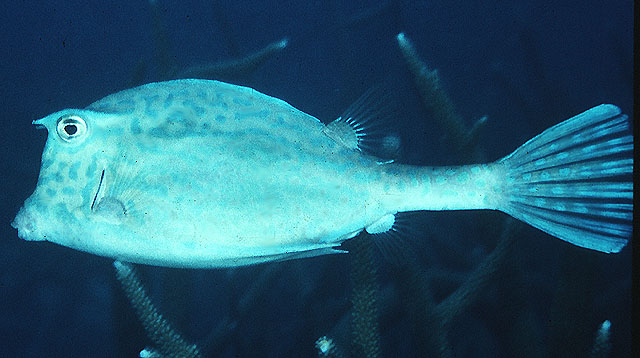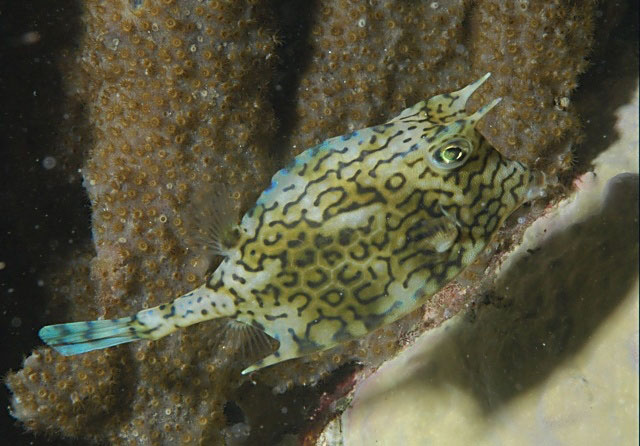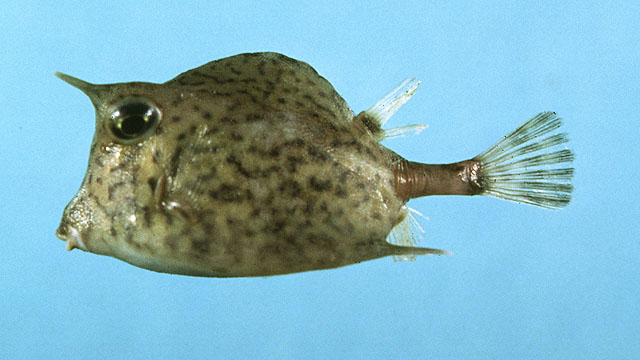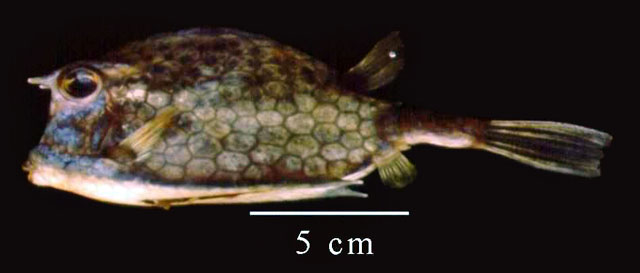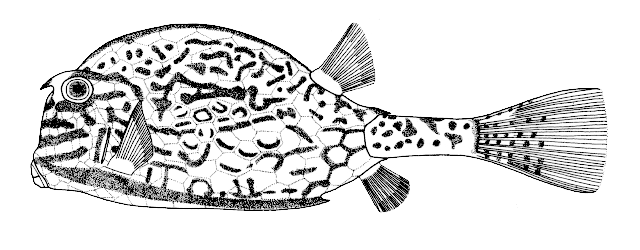Acanthostracion
quadricornis
(Linnaeus,
1758)
Scrawled cowfish
View all media / Upload your photos and videos
Expand all
Classification / Names
Teleostei (teleosts) > Tetraodontiformes (Puffers and filefishes) >
Ostraciidae (Boxfishes)
Etymology: Acanthostracion: Greek, akantha = thorn + Greek, ostrakon = shell (Ref. 45335).
More on author:
Linnaeus.
Environment / milieu / depth range / climate zone / distribution range
Distribution
Atlantic Ocean: in tropical and temperate waters (Ref. 3696). Western Atlantic: Massachusetts (USA), Bermuda, and northern Gulf of Mexico to southeastern Brazil. Reported from tip of South Africa.
Maps

Acanthostracion quadricornis / Native range
AquaMaps Data sources:
GBIF
OBIS
This map was computer-generated and has not yet been reviewed.

Acanthostracion quadricornis / Suitable habitat
AquaMaps Data sources:
GBIF
OBIS
This map was computer-generated and has not yet been reviewed.

Acanthostracion quadricornis / Point map
AquaMaps Data sources:
GBIF
OBIS
This map was computer-generated and has not yet been reviewed.

Acanthostracion quadricornis / Year 2050
AquaMaps Data sources:
GBIF
OBIS
This map was computer-generated and has not yet been reviewed.
Length at first maturity / Size / Weight / Age
Short description
Dorsal spines (total): 0; Dorsal soft rays (total): 10; Anal spines: 0; Anal soft rays: 10. Dark markings on head and body; parallel bands on cheek. Pair of prominent spines projecting from in front of eyes suggests cow horns. Second pair of spines at lower rear corners of cuirass (Ref. 26938). Body deep, covered with hexagonal dermal plates (Ref. 37521).
Biology
Found in shallow water down to about 80 m, mainly in seagrass beds (Ref. 3696). Feeds on sessile invertebrates such as tunicates, gorgonians and anemones, as well as on slow-moving crustaceans, sponges (Ref. 3696), hermit crabs and marine plants (Ref. 13442). Oviparous (Ref. 205). Considered an excellent food fish; marketed fresh (Ref. 3696).
Main reference
Smith, M.M. 1986 Ostraciidae. p. 890-893. In M.M. Smith and P.C. Heemstra (eds.) Smiths' sea fishes. Springer-Verlag, Berlin. (Ref. 3141)
IUCN Red List Status (Ref. 125652)
Least Concern (LC); date assessed: June 07 2011
CITES (Ref. 123416)
Not Evaluated
CMS (Ref. 116361)
Not Evaluated
Threat to humans
Reports of ciguatera poisoning (Ref. 30303)
More information
- Countries
- FAO areas
- Ecosystems
- Occurrences
- Introductions
- Stocks
- Ecology
- Diet
- Food items
- Food consumption
- Ration
- Common names
- Synonyms
- Metabolism
- Predators
- Ecotoxicology
- Reproduction
- Maturity
- Spawning
- Spawning aggregation
- Fecundity
- Eggs
- Egg development
- Age/Size
- Growth
- Length-weight
- Length-length
- Length-frequencies
- Morphometrics
- Morphology
- Larvae
- Larval dynamics
- Recruitment
- Abundance
- References
- Aquaculture
- Aquaculture profile
- Strains
- Genetics
- Allele frequencies
- Heritability
- Diseases
- Processing
- Mass conversion
- Vision
- Pictures
- Stamps, Coins Misc.
- Sounds
- Ciguatera
- Speed
- Swim. type
- Gill area
- Otoliths
- Brains
Estimates based on models
Preferred temperature (Ref. 123201): 22.3 - 28, mean 25.4 °C (based on 458 cells).
Phylogenetic diversity index (Ref. 82804): PD50 = 0.5625 [Uniqueness, from 0.5 = low to 2.0 = high].
Bayesian length-weight: a=0.03981 (0.02306 - 0.06873), b=2.70 (2.54 - 2.86), in cm total length, based on LWR estimates for this species & (Sub)family-body (Ref. 93245).
Trophic level (Ref. 69278): 2.7 ±0.2 se; Based on diet studies.
Resilience (Ref. 120179): High, minimum population doubling time less than 15 months (Fec = 112,536).
Fishing vulnerability (Ref. 59153): Moderate vulnerability (42 of 100).
Price category (Ref. 80766): High; Very questionable: based on ex-vessel price for species in this family.
Nutrients (Ref. 124155): Calcium = 22.3 [9.0, 63.2] mg/100g; Iron = 0.615 [0.308, 1.471] mg/100g; Protein = 18.8 [16.5, 21.0] %; Omega3 = 0.153 [0.077, 0.296] g/100g; Selenium = 24 [10, 55] μg/100g; VitaminA = 18.4 [4.2, 81.7] μg/100g; Zinc = 0.73 [0.46, 1.17] mg/100g (wet weight);

